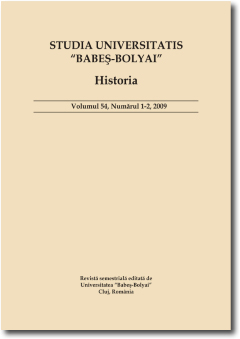SEVENTEENTH CENTURY MIRACLES OF ST. JOHN THE NEW AND THEIR IMPACT ON HIS CULT IN EARLY-MODERN MOLDAVIA
SEVENTEENTH CENTURY MIRACLES OF ST. JOHN THE NEW AND THEIR IMPACT ON HIS CULT IN EARLY-MODERN MOLDAVIA
Author(s): Elena FireaSubject(s): History
Published by: Studia Universitatis Babes-Bolyai
Keywords: St. John the New from Suceava; Peter Mohyla; the cult of saints; miracles; popular veneration of saints.
Summary/Abstract: Before Peter Mohyla’s precious testimony concerning the three recently performed miracles of St. John the New, extant internal sources do not contain any reference to the miraculous activity of his relics deposited at Suceava during the first two centuries after the cult was adopted in Moldavia. The silence of the sources has fostered skepticism in the existing scholarly literature concerning the manifestation of the miraculous powers of the relics in question and it is generally believed that, before the first decades of the seventeenth century St John the New had remained a „deus otiosus”. By inventorying and evaluating all direct and indirect evidence concerning the thaumaturgic virtues of St. John the New, the present study reaches different conclusions in this respect. Although disparate and laconic, the few preserved clues suggest that the relics of the martyr venerated at Suceava were perceived as miracle-working also during the fifteenth and sixteenth centuries. In the absence of more specific descriptions, it can be surmised that these were mostly miraculous healings performed near the saint’s shrine, which generated local forms of pilgrimage enhancing, at the same time, the reputation of St. John the New as a thaumaturg in other territories, sometimes as far as Moscow. Obviously, the public veneration of the relics connected to their miraculous virtues increased at the end of the sixteenth century and the begining of the following, when the more systematic attempts to record these miracles in writing were also made, culminating in Peter Mohyla’s manuscript. Discussing the three narratives that have St. John the New as a protagonist in the context of the more general goals of the manuscript and the religious climate in which this text was written, but also in relation to the internal development of the cult, the second part of the study focuses on the analysis of the early modern miracles of the saint and on their impact on popular devotion. A consequence rather than a cause of the revitalization of the cult at this time, in the version recorded by Peter Mohyla, these miracles reflect the views of the ecclesiastical elite concerning the veneration due to the relics at Suceava and the devotional patterns recommended. Against the background of increased interest in miracles at this particular time, the distinct character of these divine interventions, especially when compared with previous ones outlines not so much the profile of a thaumaturg saint as that of an advocate of right belief and defender of Orthodoxy in the context of confessional polemics but also an efficient protector of the community under his patronage.
Journal: Studia Universitatis Babes-Bolyai - Historia
- Issue Year: 58/2013
- Issue No: Special
- Page Range: 196-229
- Page Count: 34
- Language: English

